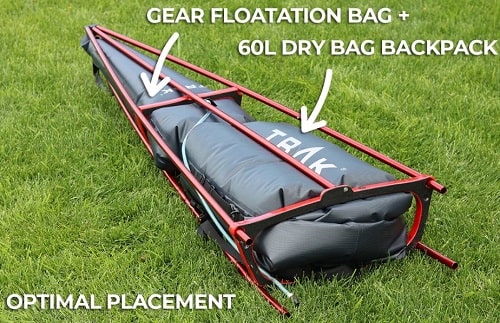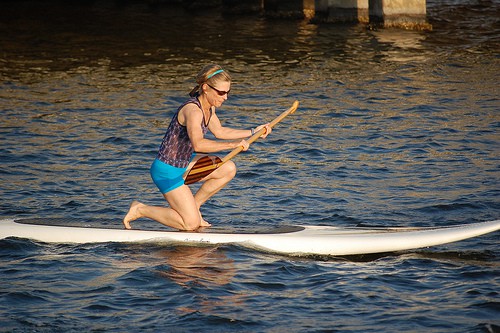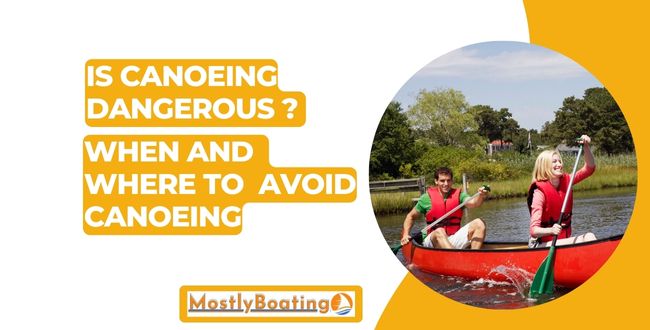Recreation activities have been captivating the hearts of millions and canoeing is no exception. The paddle propulsion system provides a low-impact workout, while sightseeing is a pure source of fun.
However, mother nature can be fickle and can bring challenges while you’re enjoying the leisurely treat on the calm waters. So, is Canoeing dangerous? Well, not at all!
But of course, you need to take a few safety measures before hopping on your beloved watercraft. Mainly, this includes wearing a life jacket, being aware of dangerous situations, and only having a ride in rivers that are considered ideal for canoe rides.
Read on to learn more about the dangers associated with canoeing and how to remain safe while you’re out on the water.
Is Canoeing Dangerous – Let’s Bust this Myth
The only ‘one-kind-of’ answer I can give to this query is yes, canoeing is definitely safe if you follow all the precautions.
First up, you should learn how to launching a canoe and how to maintain your balance. It indicates that beginners should start off their first couple of rides on calm and steady water with no aquatic obstacles.

However, if you’re a pro, simply jump in your canoe and let the adventure begin. Attention; don’t forget to take safety equipment and follow precautionary measures like the life jacket. After all, no one wants to get their surface off in the middle of the river.
Moving forward, you should also keep an eye on the weather, as nature is unpredictable. There’s a high chance of your watercraft getting tipped over in stormy winds or heavy rainfalls.
Do you know that more than 636 people died in 2022 each year as a result of boating fatalities? With that being said, many recreational boaters wonder if is canoeing dangerous.
Is Canoeing Dangerous or Safe for Kids?
Canoeing is an exciting adventure for kids, but it’s important to address the question of safety. While there are inherent risks, with proper precautions, canoeing can be a safe activity for children.
For instance, you must ensure that your child wears properly fitted life jackets or personal flotation devices (PFDs) at all times while on the water. In addition, supervision is paramount when children participate in such activities, because even standing in a canoe isn’t a good idea for a beginner especially for child.
Adhering to precautions along with some safety measures I have outlined in this article makes canoeing a safe water sport for both kids and adults.
What Makes Canoeing Dangerous?
No doubt, every water sport is associated with significant dangers. Just as that, canoeing can also be hazardous in certain instances.
Here are the instances when safe water sports become dangerous:
Poor Entry and Exit from The Canoe
For sure, poor entry and exit from the canoe is surely a danger. Though you’re near the shore while getting into a canoe or out from your it, you might get an injury.
Falling Out of the Canoe
When a canoe capsizes or you fall out of it, the scenario is just unimaginable. Fortunately, you could get back to your watercraft with the help of the steps I have mentioned below:

- Stay calm and assess the situation.
- Flip the canoe upright if necessary.
- Approach the canoe from the side and reach across the canoe to grab the opposite gunwale.
- Kick your legs and pull yourself up onto the centerline of the canoe.
- Slide or crawl back into the canoe, using your hands for support.
- Once stable, retrieve any floating gear and paddle back to shore.
Failing to Wear a Life Vest
Being without a life vest while canoeing is another significant risk factor. A life vest provides buoyancy and can be a lifesaver in case of a capsize or if you become fatigued while swimming.
Even if you’re a strong swimmer, unexpected circumstances such as strong currents or exhaustion make it difficult to stay afloat without a PFD. So never make your swimming ability an excuse for not wearing a life jacket.
Canoeing in Deep Waters When You’re Unaware of How to Swim
Another perilous situation arises when canoeing in deep waters without knowing how to swim. While it may seem obvious, it’s crucial to have swimming skills before venturing into deep waters in a canoe.
In the event of a capsize or accidental immersion, being able to swim helps you stay afloat, make it to shore, or reach safety. If you don’t have swimming skills, just drop the idea to go into deep water and enjoy a safe aquatic treat.
Canoeing Near Dams and Waterfalls
Canoeing near dams and waterfalls poses additional risks. These areas often have strong currents, turbulent waters, and undertows that can pull a canoe and its occupants into dangerous situations.
Moving forward, the force of the water can easily capsize a canoe or trap it against rocks or debris, increasing the chances of injury or drowning.
Canoeing Near Large Boats
Canoeing near large boats can be hazardous. As large vessels move through the water, they create significant waves. These waves can be powerful and have the potential to capsize a little vessel and throw its occupants off balance.
When and where to avoid canoeing?
Navigating the vast waters with a canoe can be an exhilarating adventure, but like any outdoor pursuit, it’s important to be cautious and make smart moves.
Let’s explore some situations where you must steer a canoe properly or even avoiding it.
Canoeing in Bad Weather
Though canoeing can be an exciting escapade, venturing out in harsh weather conditions is like taking an unexpected detour into a suspense thriller. The elements can transform a serene paddling trip into a wild and unpredictable adventure.
When it comes to bad weather, it’s best to stay on the side of caution and hang up those paddles for a sunnier day.
Canoeing in Cold Weather
When winter wraps its icy grip around the world, having a canoe ride isn’t a good idea. You will be more susceptible to hypothermia due to freezy water and cold weather.
Hence, it’s wise to reserve the venture for warm months with scorching sun. The icy water is more than just a requirement in such a hot season.
Let’s assume you challenge yourself to a cold water canoe ride and fall into the water for some reason (I never wish that). At that time, there’s a risk of getting hypothermia.
Luckily, you could minimize the risk by following the steps given below:
- Act quickly to prevent further loss of body heat and increase your chances of survival.
- If a boat capsizes, try to right it or climb on top of it if possible.
- Tighten your clothes to reduce heat loss and cover your head to minimize exposure.
- Stay still and remain in a position that minimizes heat loss
- Avoid swimming unless it’s necessary to reach a nearby boat, as swimming uses up energy and accelerates heat loss, reducing your survival time.
- If you are in the water with others, huddle together closely to share body heat and increase warmth.
Canoeing in the Ocean
Can Canoes Go In The Ocean? It’s no secret that canoeing in serene lakes or winding rivers can be a delight, the ocean is a different beast altogether. The ocean is a formidable force, and its unpredictable tides and currents can catch even experienced paddlers off guard.
A beginning rule of thumb indicates that canoeing is most suitable on calm rivers. If you’re an ocean lover or an open-sea admirer, go on a ride for a kayak or larger vessels that are better equipped to tackle the challenges the water body presents.
Best Practices for Maintaining Balance on Canoe
Mastering the art of canoeing requires more than just paddling skills and a love for boating. As mentioned earlier, you must first learn to maintain your balance as a newbie canoe rider.
For your ease, I have listed down some effective techniques that will help you to develop your balance:
- Find your center in the canoe by positioning yourself in the middle and facing forward.
- Ensure balance by distributing your weight equally on both sides of the canoe.
- Maintain stability with a low and steady center of gravity.
- Stay relaxed and flexible in your posture to adapt to the water’s movements.
- Make adjustments to your seating position as necessary to achieve optimal balance.
Must Take These Precautions For Ensuring Safety
A well-said quote, ‘Prepare for the worst, expect the best’ perfectly fits here. Though you might expect an enjoyable scenario in this fun water venture, things can go wrong.
Being prepared for every mishap ensures that you will safely return to the shore. Here are a few major safety precautions one should follow before going for a canoe ride:
Wear a Life Jacket or PFD
The first and most critical precaution for ensuring safety during any water activity is to wear a properly fitting life jacket or PFD. These lifesaver tools are designed to keep you afloat and provide buoyancy in case of an emergency.
Let Someone Know
Adventure is best enjoyed when shared, so before you embark on your aquatic voyage, make sure to let someone responsible know about your plans. Inform a friend, a family member, or a fellow water enthusiast who can keep an eye on your itinerary and especially when you’ve gone for a day long paddling trip, where you might think of sleeping in a canoe, and other stuff.
After all, it’s always comforting to have someone looking out for you from the shore, ready to sound the alarm if you don’t return as expected.
Check the Weather
Mother Nature can be unpredictable, especially when it comes to the weather. Before heading out, be sure to check the forecast and keep an eye on any updates.
Strong winds, thunderstorms, or rough waters can pose serious risks. Hence, you must stay informed and make smart moves to avoid potentially hazardous conditions.
Have Supplies
Proper preparation is key when it comes to safety. Pack essential supplies such as a first aid kit, sunscreen, drinking water, snacks, and any necessary medication.
Additionally, consider bringing a whistle, a flashlight, and a fully charged mobile phone in case of emergencies. Being equipped with the right gear will ensure that you’re ready to handle unexpected situations with ease.
Consider Using Outriggers For Extra Stability
Canoeing is a type of recreational activity that demands additional stability. If you’re engaging in such an activity, consider using outriggers.
Basically, they are attachments that add stability and balance to your watercraft. They can enhance your safety by reducing the risk of capsizing or losing balance, particularly in rough or challenging waters.
Stay Aware of What to Do in a Tip Over Situation
Now, let’s talk about a dreaded but crucial scenario: a tip over. It’s essential to stay aware of what to do if you find yourself in such a situation.
When you encounter such a situation, keep calm and remember to cling to your canoe or grab hold of your paddle. With a clear head and some basic knowledge of self-rescue techniques, you’ll swiftly turn the tide and find yourself back on the right track.
Avoid Sinking With Canoe Float Bags
Finally, let’s discuss a clever way to prevent your canoe from sinking in case of a mishap: canoe float bags. These inflatable lifesavers provide extra buoyancy and help keep your canoe afloat, even in the event of a capsize.

With float bags in place, there’s no need to worry about your beloved canoe disappearing beneath the surface.
My Personal Tips Regarding Safe Canoeing
For those who wonder ‘if is canoeing dangerous’, I have listed down my personal tips regarding safe canoeing. These tips will eliminate any type of fear in your mind and ensure a safe water venture:
Master Your Paddle Strokes
Learning and practicing proper paddle strokes is essential for maneuvering the canoe effectively and safely. Here are a few essential strokes:
- Forward Stroke: The forward stroke is the basic technique for propelling the canoe in a straight line.
- Sweep Stroke: The sweep stroke is essential for making turns.
- Draw Stroke: The draw stroke is useful for moving the canoe sideways.
- J-Stroke: The J-stroke is an advanced technique that helps maintain a straight course while paddling on one side of the canoe.
Remember that efficient and controlled strokes help you maneuver the canoe effectively, maintain stability, and navigate through various water conditions.
Learn Synchronized Paddling With Your Companion
Canoeing is often a team activity involving two or more paddlers. If you’re enjoying it with a partner, synchronizing your paddling movements is paramount. Also, be sure about how many people can fit in your canoe and can paddle properly. Because, only increasing the number of paddlers isn’t good idea.
For sure, learning synchronized paddling with your companion is essential for maintaining balance, coordination, and efficiency in your canoe.
Moving forward, this synchronization minimizes the risk of accidentally tipping the canoe due to imbalanced paddling and enhances your overall paddling experience.
Kneel While Paddling
Maintaining balance is crucial for stability in a canoe. While seated, your movements can shift the center of gravity and increase the likelihood of capsizing. To enhance stability, consider kneeling in the canoe while paddling.

Indeed, the position can help to lower your center of gravity, improves balance, and distributes your weight evenly across the canoe.
Common Canoeing Hazards – Stay Safe & Enjoy this Adventure
People who wonder ‘whether is canoeing dangerous’ should be aware of common hazards associated with water sports.
Here are the major ones:
Sudden Change in River Speed
While gracefully gliding down a river, be prepared for unexpected changes in the current’s velocity. A gentle flow may abruptly transform into a rapid, demanding swift maneuvering and careful navigation.
For that reason, keeping a vigilant eye on the river ahead will help you anticipate and react to these sudden variations.
Rocks and Branches
Nature’s obstacles can sometimes test your agility and paddling skills. Rocks lurking beneath the water’s surface or protruding branches can pose a threat to both your canoe and your safety. Be sure to plan your route accordingly.
Weirs and Head Dams
These man-made structures can significantly alter the river’s behavior, creating powerful currents and turbulent waters. It’s crucial to exercise caution when approaching weirs and head dams, as the force of the water can make navigation challenging.
Planning ahead, identifying safe routes, and avoiding these structures when possible will help maintain your safety on the water.
Cold Water
Even on a warm and sunny day, the water you paddle through may retain its chilly embrace. Cold water can pose risks such as hypothermia if you find yourself unexpectedly submerged.
For your well-being during canoeing adventures, it’s essential to wear protective gear, and being mindful of the water’s temperature is essential.
Other Craft and Water Users
Sharing the waterway with other watercraft and users adds an additional element of caution. From motorized boats to kayaks and paddleboards, various vessels may cross your path.
Staying alert, maintaining a safe distance, knowing what is average canoe speed (which can be handle as well) and adhering to boating regulations (such as Canoe DUI Laws etc) ensure a harmonious coexistence on the water, minimizing the risk of collisions and accidents.
Frequently Asked Questions – (FAQs)
What should I do if my canoe capsizes?
If your canoe capsizes, stay calm and try to stay with the boat. Use it as a flotation device and swim to the nearest shore. If you can’t reach the shore, signal for help and wait for assistance.
Is it common for canoes to tip over?
Do Canoes Tip Over Easily? No, it isn’t that much easier but YES, It’s possible for a canoe to capsize. Fortunately, you can minimize the risk by maintaining proper balance, technique, and situational awareness. I would advise you to also learn how to right a tipped canoe so you are already prepared for any unpleasant experience.
Can I canoe alone or should I always have a partner?
In general, it’s wise to canoe with a partner, especially if you’re a beginner or in unfamiliar waters. Having a partner enhances safety, provides assistance during emergencies, and allows for better control and balance of the canoe.
Wrapping Up – Is Canoeing Dangerous
At the end of the day, the answer to the query ‘Is canoeing dangerous’ is absolutely not if you follow proper safety measures. After all, safety should be your top priority for any water venture.
Remember every experience is safe when you’re fully prepared for it. So don’t wait; just hop off on your canoe (adhere to all the precautionary measures as well).

Passionate freelance writer and certified boat captain, Sam brings his expertise to this pedal boating & Canoeing blog. With a knack for captivating storytelling and in-depth knowledge of boating regulations, he’s here to make your boating experience even more enjoyable and informed.
